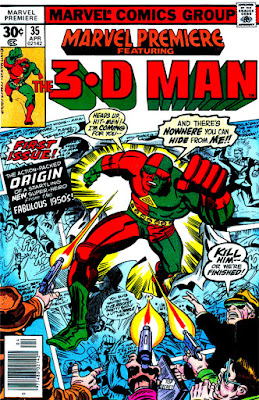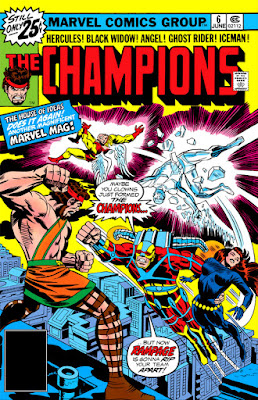In early 2003, when my interest in comics collecting was beginning to wane, there were two series which were also coincidentally drawing to a close, yet titles that I'd enjoyed investing time in--
Thunderbolts (which a friend had recommended to me--thanks, Jai!), and
Black Panther, helmed by writer Christopher Priest (as simply "Priest" in the credits) who took the series all the way to the finish line in an impressive five-year run.
Thunderbolts, running a year longer, was begun by Kurt Busiek, though Fabian Nicieza would pick it up with issue #34 and bring it to with arm's reach of the point of its hiatus
*--that is, in terms of the Thunderbolts characters that Nicieza had scripted.
*For our purposes, we need only focus on the title's issues numbering 1-81. Like other books at this time, Thunderbolts had to navigate its own "disassembling" and consequently ended up with a fragmented run in terms of its issue numbering. Following issue #81 in September of 2003, the series picks up again with #82 in January of 2005 for an 18-issue stretch, though renumbered as issues 1-18 and "ending" in April of 2006--at which point the numbering shifts again with the next month's issue (#100, May 2006) and continuing on.
And it's at that point that Thunderbolts took a detour into the bizarre.
Each of these series would for all intents and purposes come to a screeching halt in terms of the book and character(s) which the reader might have been expecting to find after tendering $2.25-$2.50. The latter price applied to the Black Panther mag, though you'd think T'Challa could do without a 25¢ markup; think of that quarter going toward an extra page that provided a heads-up as to what you'd find in the book's next issue, if woefully short on details.
What we can at least infer from these endorsements is that Priest would continue as the book's writer, albeit with a different art team--and that whatever material that would be coming our way will be part of a story arc, which Priest admittedly handles quite well. As for whether Priest will be writing the character you know as the Black Panther--well, after a glance at the issue's cover and title page, you tell me.
Not enough here for you to make up your mind? Fair enough--how about a couple of more covers? Most of them will look the same, with variations, but essentially bringing you the BLAM BLAM BLAM Black Panther.
As for Thunderbolts, which didn't give an inkling of its next issue's content or direction, we find that its story format has been radically altered, its masthead virtually hijacked, and, wait for it... NO THUNDERBOLTS.
To make things even more perplexing, Marvel's digital copy of this first issue substitutes the previous issue's page one--though both print and digital issues feature a lone caption on the cover that presumably seeks to soften the blow for the Thunderbolts reader who might have been expecting (say it with me) a Thunderbolts story.
As to the new format, your first assumption here going in might be that some or all of the characters in this six-issue story would eventually become "the new Thunderbolts" that Page One is announcing--some of whom, like their predecessors, are super-villains looking to put their criminal past behind them. (In this case, the reason mainly due to having had too many run-ins with Spider-Man--Man-Killer, for instance, who receives more focus here than in most of her previous appearances.) But other than that loose association with the original concept for the Thunderbolts, you won't find the word itself mentioned in a single panel of the entire story, though we come tantalizingly close when Man-Killer, the Scorpion, and his companion Delilah meet with the story's principal character, Daniel Axum (the Battler), to join them in getting revenge on Spider-Man.


Given separate developments that take place involving Axum and Man-Killer, however, nothing really comes of this conversation, while Gargan and Delilah soon wind up captured by Spider-Man. Through it all, the book appears to depend on its cheesecake covers and tabloid format to tempt more readers, some of whom no doubt are wondering what the heck any of this has to do with the Thunderbolts.
(A clever play on words as far as the captions for issue #81's cover, which collectively appear to wonder if anyone was still reading Thunderbolts by the time this final issue of the story hit the stands.)
All of that said, the main story with Axum is a decent read, courtesy of writer John Arcudi, with the character's affirmation arriving in the final issue at the point where he's tempted to throw in with Gargan, Man-Killer, and Delilah, until a conversation he has with the Armadillo--now derelict after Axum defeated him and took his place in an underground fight league--reminds him indirectly of why he wanted to stick to the straight and narrow after Spider-Man put him in prison for three years.

As for Black Panther, while there are allusions to and sparse appearances by T'Challa whose role here is cloaked in mystery, the story arc's protagonist is Kasper Cole, who lives with his mother and his pregnant girlfriend in Harlem where we find him at loose ends while suspended for five days from the police force--but, after finding the Panther costume in an alley, decides to don it for its bulletproof protection and go out at night anonymously to do police business. The "hook" that Priest provides which is likely meant to pique the reader's interest in this new Panther, and in the story in general, takes place when Cole encounters the White Wolf (or, rather, the other way around), and an explanation of sorts is forthcoming.


Whether or not the "don't miss it" collective vibe of Messrs. Almond, Raicht, Marts, and Ms. Suma or the stamp of approval from Mr. Busiek was enough to sway you toward sitting down with these stories is something which you'll hopefully share, as well as whether or not those efforts panned out for you. For myself, I must admit to originally picking up just the first two issues of the Thunderbolts story before removing it from my pull list, though I was obliged to finish it at long last for the purpose of this review. The Black Panther story, however, I stuck with from start to finish, and was generally satisfied at the time with how Priest handled it--though I would say that it may be suited to more of a Masterworks or TPB presentation which allows the reader to binge through it rather than experience a lag between issues where one doesn't necessarily recall the pieces of the puzzle which Priest has supplied throughout. For those of us who read these issues when they were published in 2003, the decision to release the last six issues on a biweekly schedule turned out to be a big help in that regard.









































